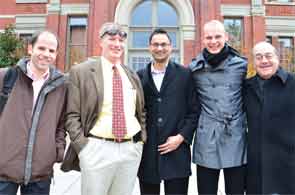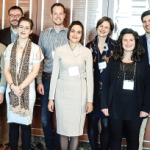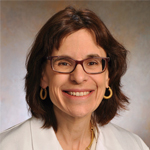
About the Program
The ACR/EULAR International Academic Exchange Program recognizes outstanding early career faculty in rheumatology research—both basic and clinical—and exposes them to the work being done by colleagues overseas. The program allows participants to share knowledge and experience, while creating an opportunity for future collaboration. To learn more, visit www.eular.org and click on “EULAR/ACR exchange” under the Education tab. The next call for applications will be in spring 2014.
Initiated in 1997, the ACR/European League Against Rheumatism (EULAR) International Academic Exchange Program (AEEP) aspired to bring together young rheumatologists from North America and Europe. Since then, more than 40 junior physician-scientists and their senior mentors have travelled across the Atlantic Ocean to share knowledge, experiences, and perspectives with their counterparts from across the pond. The original format of the program has remained virtually unchanged. After attending the annual meeting of the ACR, three European junior rheumatologists visit three selected rheumatology centers in the U.S. The following year, three American fellows attend the annual meeting of EULAR and, thereafter, travel to three European rheumatology centers. Two senior mentors, one representing the ACR and the other EULAR, accompany both groups. Economic tightening led to the AEEP’s suspension between 2009 and 2011, but was then revived by the common efforts of the ACR, EULAR, and Emerging EULAR Network (EMEUNET) in 2012. Fortunate to be among the first participants following its restoration, we would like to impart our personal experiences and discuss the value of this program.
The 2012 Program
Originating from different corners of Europe and investigating various aspects of rheumatologic disease, our heterogeneity fueled diverse conversations. Together with Randy Cron, MD, PhD, and Gabriel Panayi, MD, DSc, our two senior mentors, our interests spanned rheumatology and included inflammatory arthritis, vasculitis, scleroderma, and macrophage activation syndrome. By strategic design, the heterogeneity was reciprocated. We were fortunate to meet colleagues, with both overlapping and distinct interests, approaches, and mentalities, who were working at widely differing institutions in terms of mission, clinical practice, and research.
During the 2012 AEEP, we visited the National Institute of Arthritis and Musculoskeletal and Skin Diseases (NIAMS) (hosted by Drs. Richard Siegel, Robert Colbert, et al.), the Johns Hopkins University Hospital (hosted by Drs. Antony Rosen, Laura Hummers, et al.), and the Feinstein Institute for Medical Research (hosted by Drs. Betty Diamond, Peter Gregerson, et al.). The typical schedule at each of these centers included an introductory session, presentations and discussions about our research projects and those of our hosts, and one-on-one conversations with experts from our shared respective specialist fields. At every site, we encountered enthusiastic interest in our projects, vivid discussions, and cordial atmospheres, which served as fertile soil to start new collaborations and build future networks. We are deeply grateful to our hosts, who seamlessly turned our busy working days into charming evening get-togethers, which were wonderful occasions to socialize with colleagues and establish new friendships.
We were impressed by the researchers at NIAMS who identified new disease mechanisms by studying rare diseases; we admired the balance of clinical practice and research at the Johns Hopkins University; and we marveled at the close teamwork of world-famous experts at the Feinstein Institute. Most striking of all, and common to all aspects of our journey, was the enthusiasm for mutual learning underscored by the importance of savoring continental difference.
How to Measure the Success of the Program?
Apart from the clear individual benefits, a program supported by the ACR and EULAR needs to pay off for the wider rheumatology community. We, therefore, asked ourselves what the benefits of the AEEP might be, how they could be measured, and when they might become evident. These questions need to be addressed thoroughly, especially in these times of austerity. In a recent editorial, Drs. Randy Cron and Hendrik Schulze-Koops evaluated the long-term benefits of the AEEP.1 Among their evidence to support the program were more than 40 publications emerging from intracontinental collaborations between former AEEP participants as well as another 40 manuscripts deriving from intercontinental AEEP collaborative efforts. Drs. Cron and Schulze-Koops also observed that, so far, many of the AEEP “junior” faculty participants have proceeded to rheumatology directorships in the U.S. and Europe.
When it comes to short-term effects of the program, objective measures are barely available and it is up to us, the participants, to collect pieces of evidence that the AEEP has positive impact on our careers and the community.2,3 This evidence will include recent advances in our research projects or new collaborations set up during the program. In addition to research collaborations, the AEEP is likely to help in laying the groundwork for accruing patients for cross-continental clinical trials. Invited talks and literature reviews are other subtle signs that the AEEP does have these short-term benefits.
Thus, we conclude that the AEEP may indeed have measurable benefits for both the participants and the community. We are sure that the AEEP will shape our future careers and we believe that the AEEP is a future investment of the rheumatology community that will prove its worth many times over. We would like to thank both the ACR and EULAR for reviving this unique platform for transatlantic research exchange. Finally, we would like to strongly encourage both junior and senior physician-scientists from North America and Europe to participate in this exceptional program.
Acknowledgments
We would like to thank the ACR, EULAR, and EMEUNET for providing this unique exchange program. Special thanks to Megan Blake and her colleagues from the ACR and EULAR for organizing travelling and housing in the U.S. Many thanks for the hosting institutions, and all the colleagues who attended the sessions. Most importantly, special thanks to Drs. Cron and Panayi for their mentorship during the 2012 program.
Dr. Beyer is in the department of internal medicine 3 and Institute for Clinical Immunology at the University of Erlangen-Nuremberg, Germany. Dr. Basu is in the epidemiology group at the Institute of Applied Health Sciences at the University of Aberdeen, U.K. Dr. Scherer is in the department of rheumatology at Leiden University Medical Center, The Netherlands.
References
- Cron RQ, Schulze-Koops H. 1.5 Decades Later: Bearing fruits from the ACR/EULAR exchange Program. Pediatr Rheumatol Online J. 2011;9:14.
- Hueber AJ, Distler JH, Fritsch-Stork RD. International rheumatology networking: The 2008 American College of Rheumatology/European League Against Rheumatism exchange program. Arthritis Rheum. 2009;60:1881-1883.
- Elewaut D, Aringer M, Muller-Ladner U. Getting scientists together: The ACR/EULAR exchange programme. Ann Rheum Dis. 2003;62:789-790.


